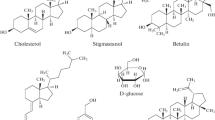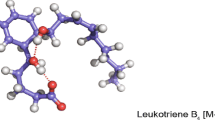Abstract
Monomethyl and dimethylalkanes with one, two, three, four, five, and seven methylene groups separating the methyl branches were synthesized and analyzed by magnetic sector and quadrupole storage (ion trap) mass spectrometry. The spectra produced by the magnetic sector instrument were in good agreement with previously reported data, whereas the ion trap spectrometer produced ions resulting from cleavages adjacent to the branching points, markedly different than those from the magnetic sector instrument. Fragmentation patterns show that the ion trap mass spectrometer can be used to characterize branched alkanes in nanogram and subnanogram quantities.
Similar content being viewed by others
References
Alborn, H.T., Doolittle, R.E., Zanen, P.O., Cardé, R.T., andTumlinson, J.H. 1995. Oviposition kairomones ofBrachymeria intermedia a parasite of gypsy moth pupae.J. Chem. Ecol. In press.
Biemann, K. 1962. Mass Spectrometry Organic Chemical Applications, p. 80. McGraw-Hill, New York.
Blomquist, G.J., andDillwith, J.W. 1985. Cuticular lipids, pp. 121–125,in G.A. Kerbut and L.I. Gilbert (eds.). Comprehensive Insect Physiology, Biochemistry, and Pharmacology. Vol. 3. Pergamon Press, Elmsford, New York.
Hadley, N.F. 1994. Water Relations of Terrestrial Arthropods. Academic Press, San Diego.
Jackson, L.L., andBlomquist, G.J. 1976. Insect waxes, pp. 201–233,in P.E. Kolattukudy (ed.). Chemistry and Biochemistry of Natural Waxes. Elsevier, Amsterdam.
Jacob, J. 1979. Chemosystematic observations on the cuticular lipids of beetles.Biochem. System. Ecol. 7:141–145.
Jones, R. L., Lewis, W.J., Bowman, M.C., Beroza, M., andBierl, B.A. 1971. Host-seeking stimulant for parasite of corn earworm: Isolation, identification, and synthesis.Science 173:842–843.
Lockey, K.H. 1976. Cuticular hydrocarbons ofLocusta, Schistocerca andPeriplaneta, and their role in waterproofing.Insect Biochem. 6:457–472.
Lockey, K.H. 1978. The adult cuticular hydrocarbons ofTenebrio molitor andTenebrio obscurus (F.) (Coleoptera: Tenebrionidea).Insect Biochem. 8:237–250.
Lockey, K.H. 1980. Insect cuticular hydrocarbons.Comp. Biochem. Physiol. 65B:457–462.
March, R.E., andHughes, R.J. 1989. Dynamic range and detection limit, pp. 334–335,in J.D. Winegardner (ed.). Quadrupole Storage Mass Spectrometry: Chemical Analysis, Vol. 102. John Wiley & Sons, New York.
McCarthy, E.D., Han, J., andCalvin, M. 1968. Hydrogen atom transfer in mass spectrometric fragmentation patterns of saturated aliphatic hydrocarbons.Anal. Chem. 40:1475–1480.
Nelson, D.R., andSukkestad, D.R. 1970. Normal and branched aliphatic hydrocarbons from the eggs of tobacco hornworm.Biochemistry 9:4601–4611.
Nelson, D.R., andSukkestad, D.R. 1975. Normal and branched alkanes from cast skins of the grasshopperSchistocerca vaga (Scudder).J. Lipid Res. 16:12–18.
Nelson, D.R., Sukkestad, D.R., andZaylskie, R.G. 1972. Mass spectra of methyl-branched hydrocarbons from eggs of the tobacco hornworm.J. Lipid Res. 13:413–421.
Phinney, C.S. 1993. Enhancement of molecular ion detection by variation of mass analyzer thermal energy for C10-C24 alkanes by ion trap mass spectrometry. Proceedings of the 41st American Society of Mass Spectrometry. conference on mass spectrometry and allied topics. San Francisco, California.
Pomonis, J.G., Fatland, C.F., Nelson, D.R., andZaylskie, R.G. 1978. Insect hydrocarbons I. Corroboration of structure by synthesis and mass spectrometry of mono- and dimethylalkanes.J. Chem. Ecol. 4:27–39.
Pomonis, J.G., Nelson, D.R., andFatland, C.L. 1980. Insect hydrocarbons 2. Mass spectra of dimethylalkanes and the effect of the number of methylene units between methyl groups on fragmentation.J. Chem. Ecol. 6:965–972.
Pomonis, J.G., Hakk, H., andFatland, C.L. 1989. Synthetic methyl- and dimethylalkanes Kovats indices, [13C]NMR and mass spectra of some methylpentacosanes and Z. X-dimethyl-heptacosanes.J. Chem. Ecol. 15:2319–2333.
Sonnet, P.E. 1976. Synthesis of 1,5-dimethylalkanes, components of insect hydrocarbons.J. Am. Oil Chem. Soc. 53:57–59.
Spiteller, G. 1966. Massenspektrometrische Strukturanalyse Organisher Verbeindunger, Verlag Chemie, p. 91, Frankfurt.
Author information
Authors and Affiliations
Rights and permissions
About this article
Cite this article
Doolittle, R.E., Proveaux, A.T., Alborn, H.T. et al. Quadrupole storage mass spectrometry of mono- and dimethylalkanes. J Chem Ecol 21, 1677–1695 (1995). https://doi.org/10.1007/BF02033669
Received:
Accepted:
Issue Date:
DOI: https://doi.org/10.1007/BF02033669




